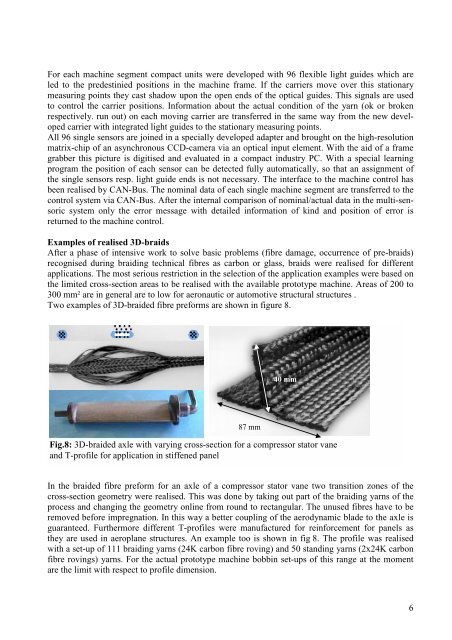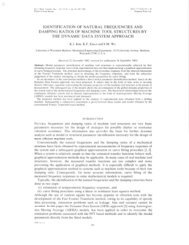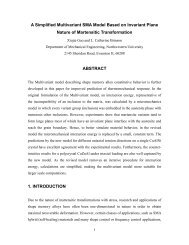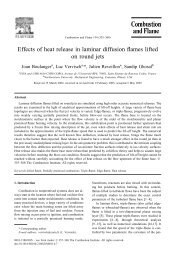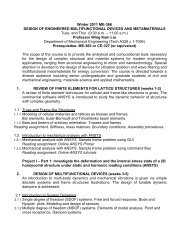Single Side Stitching, an innovative textile ... - Mechanical Engineering
Single Side Stitching, an innovative textile ... - Mechanical Engineering
Single Side Stitching, an innovative textile ... - Mechanical Engineering
You also want an ePaper? Increase the reach of your titles
YUMPU automatically turns print PDFs into web optimized ePapers that Google loves.
For each machine segment compact units were developed with 96 flexible light guides which are<br />
led to the predestinied positions in the machine frame. If the carriers move over this stationary<br />
measuring points they cast shadow upon the open ends of the optical guides. This signals are used<br />
to control the carrier positions. Information about the actual condition of the yarn (ok or broken<br />
respectively. run out) on each moving carrier are tr<strong>an</strong>sferred in the same way from the new developed<br />
carrier with integrated light guides to the stationary measuring points.<br />
All 96 single sensors are joined in a specially developed adapter <strong>an</strong>d brought on the high-resolution<br />
matrix-chip of <strong>an</strong> asynchronous CCD-camera via <strong>an</strong> optical input element. With the aid of a frame<br />
grabber this picture is digitised <strong>an</strong>d evaluated in a compact industry PC. With a special learning<br />
program the position of each sensor c<strong>an</strong> be detected fully automatically, so that <strong>an</strong> assignment of<br />
the single sensors resp. light guide ends is not necessary. The interface to the machine control has<br />
been realised by CAN-Bus. The nominal data of each single machine segment are tr<strong>an</strong>sferred to the<br />
control system via CAN-Bus. After the internal comparison of nominal/actual data in the multi-sensoric<br />
system only the error message with detailed information of kind <strong>an</strong>d position of error is<br />
returned to the machine control.<br />
Examples of realised 3D-braids<br />
After a phase of intensive work to solve basic problems (fibre damage, occurrence of pre-braids)<br />
recognised during braiding technical fibres as carbon or glass, braids were realised for different<br />
applications. The most serious restriction in the selection of the application examples were based on<br />
the limited cross-section areas to be realised with the available prototype machine. Areas of 200 to<br />
300 mm² are in general are to low for aeronautic or automotive structural structures .<br />
Two examples of 3D-braided fibre preforms are shown in figure 8.<br />
87 mm<br />
40 mm<br />
Fig.8: 3D-braided axle with varying cross-section for a compressor stator v<strong>an</strong>e<br />
<strong>an</strong>d T-profile for application in stiffened p<strong>an</strong>el<br />
In the braided fibre preform for <strong>an</strong> axle of a compressor stator v<strong>an</strong>e two tr<strong>an</strong>sition zones of the<br />
cross-section geometry were realised. This was done by taking out part of the braiding yarns of the<br />
process <strong>an</strong>d ch<strong>an</strong>ging the geometry online from round to rect<strong>an</strong>gular. The unused fibres have to be<br />
removed before impregnation. In this way a better coupling of the aerodynamic blade to the axle is<br />
guar<strong>an</strong>teed. Furthermore different T-profiles were m<strong>an</strong>ufactured for reinforcement for p<strong>an</strong>els as<br />
they are used in aeropl<strong>an</strong>e structures. An example too is shown in fig 8. The profile was realised<br />
with a set-up of 111 braiding yarns (24K carbon fibre roving) <strong>an</strong>d 50 st<strong>an</strong>ding yarns (2x24K carbon<br />
fibre rovings) yarns. For the actual prototype machine bobbin set-ups of this r<strong>an</strong>ge at the moment<br />
are the limit with respect to profile dimension.<br />
6


